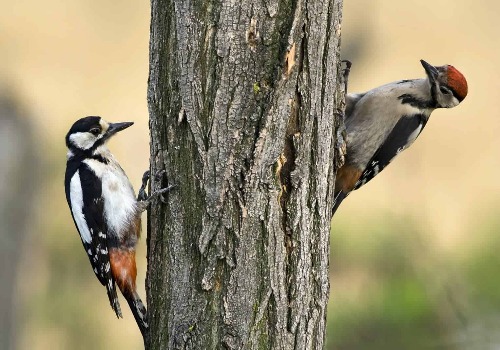Mainers have always been blessed by the vibrant personalities, bold markings, and bright colors of woodpeckers. In fact, a wide range of woodpeckers has been visiting this state for the last few centuries, particularly in summer.
However...
Have you ever wondered what the most common Maine woodpecker is? Or how can you differentiate between the different species? Well, you're in luck; in this article, we'll talk more about the most common Maine woodpeckers and the key facts about them, so let's dive right in…
The 8 Woodpeckers in Maine
Currently, there are 23 woodpecker species that are native to the U.S., and most of them visit Maine during summer. In fact, some of them can be found in Maine all year round.
In fact, the smallest species in this state is the Downy Woodpecker, while the largest is the Pileated Woodpecker. So here are some of the most common woodpeckers in Maine:
1. Hairy Woodpecker
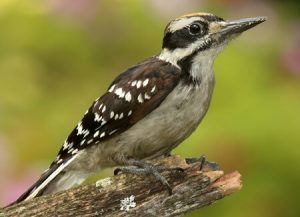
The Hairy Woodpeckers are one of the few bird species that have been compared to soldiers, thanks to their straight-backed posture and cleanly stripped heads. Appearance-wise they resemble the Downy Woodpeckers with white and black stripes and a red dot. But they are a bit larger than the Downy's in size and have all-white tail feathers.
But since they are found in the same region, differentiating the two woodpeckers can be quite challenging.
This medium-sized bird loves visiting the backyard feeders, and there are quite powerful and known for producing some explosive peak calls or whinnying sounds.
Despite being bigger than the Downys, the hairy woodpeckers are less common, but they prefer mature forests with old trees where they consume plant matter and insects. They can also be found in orchards, swamps, and suburban backyards.
Plus, they're known for following the Pileated Woodpecker in search of an easy meal. Therefore, if you want to see a hairy woodpecker, all you have to do is look for a Pileated woodpecker and wait for it to leave, and this species will fly to the hole in search of any insect left behind.
They feed on millipedes, moth pupae, spiders, caterpillars, and bees. You need a squirrel-proof suet feeder with a cage to attract the hairy woodpeckers to your backyard bird feeders. You can mix suet and black oil sunflower seeds.
Fun Fact: Did you know that this bird is also one of many Minnesota woodpeckers?
2. Downy Woodpecker
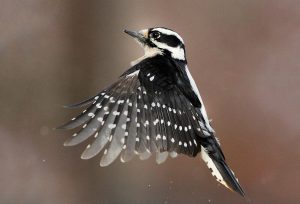
Another common woodpecker that can be found basically everywhere in Maine is the Downy Woodpecker. This bird can be found in this state all year round, and it is considered the smallest woodpecker in North America. But they are a bit bigger than a robin and smaller than a sparrow.
Mostly white and black, this bird has wide shoulders, blocky heads, and chisel-like straight bills, but their bill is quite small compared to other woodpeckers. The males have a unique red patch at the back of their heads.
Since they have a small body, the Downy Woodpeckers tend to move more acrobatically than the bigger woodpeckers.
So you can find them hitched around a tree trunk and limb or on tall weeds in search of galls. During summer and spring, folks living near open woodlands can enjoy their shrill whinnying call; after all, it makes a lot of noise for such a small bird.
Other than in open woodland, you can find the Downy Woodpecker in city parks, orchards, and our backyards. Plus, if you have installed a feeder in your backyard, they are likely to drop by to have a bite.
3. Northern Flicker
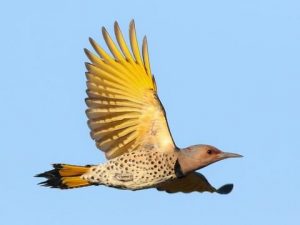
Out of all the Maine woodpeckers, the Northern Flickers are the only ones with a gray-brown plumage. And if you think it's just a common bird, you should wait until it takes off and spreads its wings. When flying, this bird's wings are known to flash yellow or red-orange.
But just like the other woodpeckers, this bird primarily lives in wetlands, woodlands, and any built-up region, making it the most common visitor at bird feeders. This beautiful bird has a spotted belly and black bib; it's the same size as American Robins.
Currently, there are two variations of this bird: the yellow-shafted and the red-shafted. The red-shafted are in the western parts of the state, and when in flight, you will notice a flash of red-orange feathers on their tail and underwing. They have a gray face with a beautiful brown crown, whereas the other variation has a gray crown with a brown face.
The yellow-shafted is in the eastern parts of the world and has a yellow tail and underwing, which becomes visible when it's flying.
Unlike most woodpeckers, this bird can be commonly seen walking vertically up tree trunks thanks to its zygodactyl feet.
It also comes with some pointed-tail feathers that protrude at a unique angle and serve as a balanced prop. This species loves breeding in Maine, so you have a high likelihood of seeing them active in spring.
They feed on insects and a wide range of invertebrates. They can also consume berries and seeds when available.
4. Red-Headed Woodpecker
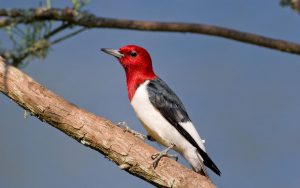
Thanks to their many similarities, the Red-Headed Woodpeckers have been confused for the Red-Belly Woodpecker. This bird breed visits the state before migrating southwards in winter; therefore, they're not common in Maine. In fact, most bird watchers refer to them as the flying checkerboards thanks to their boldly patterned bodies.
Both females and males look alike. They have a mixture of white and black, with the head being crimson red; plus, their belly is as white as snow.
Just like the hairy woodpecker, this bird is medium in size. Plus, you can always find them in a pine savannah or any other forest with a clear understory.
They have a powerful spike bill that they can even use to defend their territory. After all, they're territorial creatures that can even destroy or even remove the eggs of other birds from their territory. And what makes them unique is that they can even catch insects while in flight.
They feed on a wide range of insects, including grasshoppers, honeybees, midges, and beetles which make up one-third of their diet. The other two-thirds of their meal include plant materials like berries, nuts, and seeds. They're known to even take eggs or nestlings from other birds and even mice.
They are known to nest in a tree cavity and make a shrill call; unfortunately, their population reduced by 70% between 1966 and 2014 because of habitat loss.
5. Pileated Woodpecker
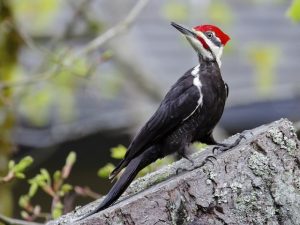
As aforementioned, there are lots of woodpeckers in Maine, but none is as huge as the Pileated Woodpecker. In fact, when folks claim that they have seen a woodpecker, they're mostly talking about this species. They're identified by their long neck, flaming-red chest, white stripes, and the triangular crest on their head.
Since the Pileated Woodpeckers are quite huge, they usually leave rectangular holes in trees when looking for carpenter ants.
Unlike most woodpeckers that hammer live trees, these species prefer softer and dead trees when looking for some food. Therefore, they can easily tear dead trees apart or leave a huge part of the tree fallen. Plus, they have a unique drumming sound when foraging in trees that speed up and slow down before speeding up again.
They're usually found in the conifer forest, but they have been moving to the parks and woodlots on the edges of cities. Fortunately, its population has been increasing over the last few years, but it's still threatened by pesticide usage and forest clearing.
6. Yellow-Bellied Sapsucker

The Yellow-Bellied Sapsucker is another Maine woodpecker that's only found in this state during the breeding season. In fact, it's considered one of the most vocal woodpeckers as it makes a lot of noise in spring with staccato drumming and cat-like calls.
They're relatively small with straight, stout bills in terms of body size. Plus, the Yellow-Bellied Sapsuckers are mostly white and black with red foreheads and patterned faces. On the other hand, the male Yellow-Bellied Sapsuckers have red throats.
They can be found in conifer and hardwood forests at an altitude of about 6,500ft. They love building their nests on the tree's grooves like aspens and spend a huge percentage of their winters in open woodland.
As its name suggests, the yellow-bellied sapsucker drills lots of neatly spaced small holes and returns back to them periodically to enjoy the sap that's oozing out.
The oozing sap also attracts some insects like ants which it consumes. They also garner insects on tree trunks just like the other woodpeckers.
7. Red-Bellied Woodpeckers
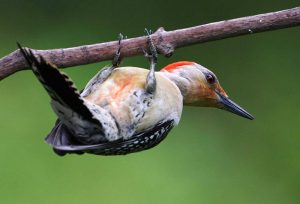
According to most bird lovers, the Red-Bellied Woodpecker is one of the prettiest birds alive. Their gleaming red nape and cap and white and black striped back make them a sight to behold. Unfortunately, most bird lovers mistake the Red-Bellied Woodpeckers for a Red-Headed Woodpecker which is ok since they have lots of similarities.
They are usually found in some old hickory and oak stands and young pines and hardwoods.
Therefore, if you live near wooded patches, then you can attract the Red-Bellied Woodpeckers to your bird feeders in winter with suet. After all, the Red-Bellied Woodpecker also loves eating sunflower seeds and peanuts. You can also find them drinking nectar from your hummingbird feeder.
Aha! Moment: Instead of drilling the bark of the trees, you can find the Red-Bellied Woodpecker pecking tree barks using their 2-inch tongues!
8. American Three-Toed Woodpecker
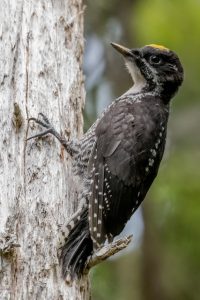
If you have ever visited or lived in the northwestern parts of this state, then you may have seen the American Three-Toed Woodpecker. Unfortunately, they are not that common; their inconspicuous nature and small size make them very hard to detect.
Unlike other woodpeckers, this species spends a very long time perching on a tree, either flaking the bark or sitting very still.
In terms of size, they are as big as American Robins; they are between the size of the Hairy Woodpecker and the Downy woodpecker. They have a fairly short bill that's sturdy and strong, which they use to pick off the tree's bark.
These birds are mostly white and black, with fine black barring on their snowy underside. The males come with a visible dull-yellow patch on their foreheads.
Watch This!
Frequently Asked Questions
What Does the Black-Backed Woodpecker Look Like?
The Black-backed Woodpecker is almost synonymous with a burned forest, and it specializes in eating beetle larvae. They’re inky black birds with some unique black barring on their flanks and a sharp white stripe on their faces. The male Black-backed woodpecker comes with yellow crown patches.
Smaller than the Northern Flickers, and bigger than the Downies, the Black-backed woodpecker is the same size as the hairy woodpecker. The head of the Black-backed woodpecker has a white marking near the eye and a single mustache.
Are Pileated Woodpeckers Rare?
No, Pileated Woodpeckers are fairly common and can be found in different parts of the United States. Their population has been growing steadily between 1966 and 2019.
What Attracts Woodpeckers to Your Backyard?
Other than providing them with their favorite meals, the first step to attracting them to your backyard is installing the right bird feeders and filling them with suet. These birds also can be attracted to apples, raisins, grapes, and cracked corn on the feeders.
Conclusion
Maine is home to some of the most beautiful birds on the planet, and this includes the biggest woodpeckers in North America. So if you want to see one of the most beautiful birds on the planet, which is the Red-bellied woodpecker, you should head to Maine. Plus, with the above facts, you can easily identify the common Maine woodpeckers.

